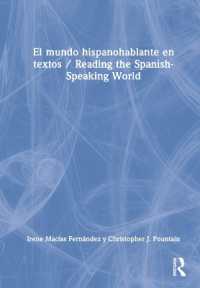Full Description
The volume provides a fresh look at contemporary Arabic literature on the experiences of migration, forced displacement and exile, with a particular focus on the period from the First Gulf War to the present.It traces thematic fusions, genre and stylistic innovations in literary works by and about migrants, refugees and other displaced persons, and covers a wide geographical area, representing not only the Arab world but also various destination countries, including Europe and North America.Questioning the impact of recent waves of forced displacement and migration from Arab countries on the literary field, the volume explores new understandings of identity and generational conflicts embedded in different types of narratives, while highlighting debates regarding displaced subjectivities and the use of the label 'refugee literature' in the Arab sphere, where this definition is widely debated.Particular attention is paid to the relationship between literature produced in countries of origin and countries of asylum, as well as to the representation of the 'state of exception' in the context of street and camp life.In addition, the volume explores the contribution of literary productions represented by poetry, prose and drama to discourses and debates on human rights, as well as the linguistic choices and aesthetic concerns within them, including formal experiments and the intersection of genres.
Contents
Notes on Contributors
Note on Transliteration
Introduction
Annamaria Bianco, Baian Rayhanova and Simone Sibilio
Part One Transcultural Aesthetics and Refugee Issues: Challenging Eurocentric Perspectives
1 Reframing the Debate on 'Arab Refugee Literature': The Syrian Response to 'Western' Labelling
Simone Sibilio
2 A Matter of Hierarchies and Classificatory Schemes: ?Ali Badr and 'Arab Refugee Literature'
Antonio Pacifico
3 Intermedial Aesthetics and Decolonial Knowledge Production in ?asan Balasim's Work
Rita Sakr
4 'Tell Us Exactly What Happened': Subverting the Asylum Story in ?amu?il Sham?un's ?Iraqi fi Baris
Federico Pozzoli
Part Two Forced Displacement, Legacies of War and Their Gendered Dimensions
5 Time and Space in Miral al-?a?awi's Novel Bruklin hayts
Baian Rayhanova
6 The Text within the Text in Maha ?asan's and Dima Wannus's Novels
Lovisa Berg
7 Syrian Women Speak: Refugee Witnesses in Samar Yazbik's Work
Giulia Spadoni
8 A Feminine Poetics of Liminality in Iman ?umaydan's Novels
Darejan Gardavadze
Part Three Shifting Subjectivities in Diaspora and Refugee Camps
9 The Palestinian Refugee Camp as a Marginal Space: Mukhmal by ?uzama ?abayib
Annamaria Bianco
10 Velvet-Wrapped Refugee Life in ?uzama ?abayib's Novels
Dorit Gottesfeld
11 Shatila Stories: The 'Nomadic Thought' within the Camp
Paola Viviani
12 Manifold Representations of Ghurba in Julan ?aji's Poetry: Translation at the Core of the Creative Process
Patrizia Zanelli
Part Four Language, Myth and Identity through the Prism of Difference
13 Christian Vernacular in Ya Maryam by Sinan An?un
Tetz Rooke
14 An Old Wise Woman Fighting War and Destruction in Isma?il Fahd Isma?il's al-Sabiliyyat
Stephan Guth
15 Nuri al-Jarra?'s Poetry: A Saidian Humanistic Reading
Francesca Maria Corrao
16 IMedea by Sulayman al-Bassam: From Ancient Myth to Modern Migration
Monica Ruocco
17 Refuge Theatre as Crime Fiction in Wa?il Qaddur's Plays
Daniela Potenza
Index








